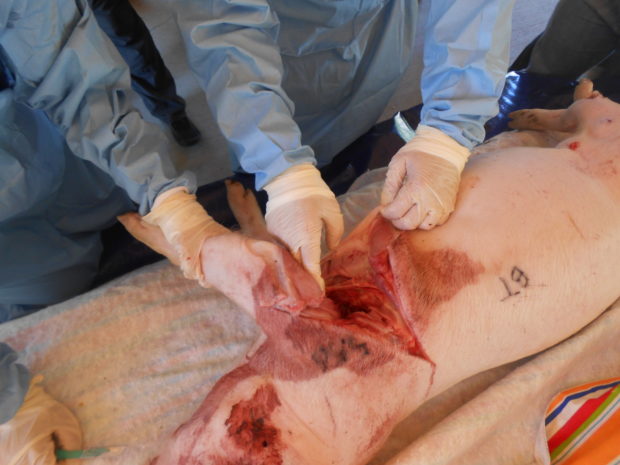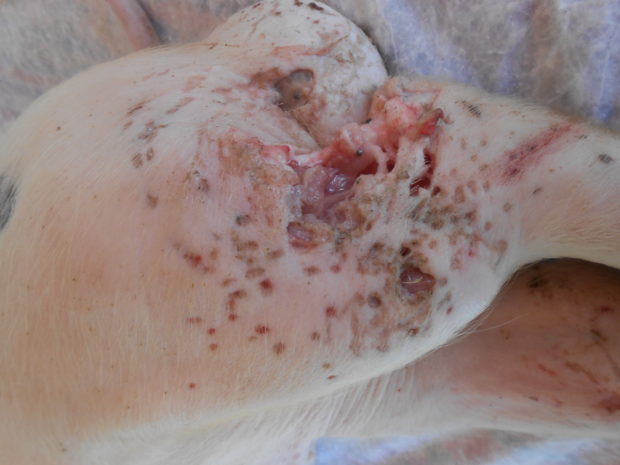In my AAR of the Paul-E-Palooza 2 training event, I mentioned that one of the medical classes involved a wound ballistics lab where two (humanely killed) pig carcasses were shot with various weapons in order to take a look at the accompanying tissue damage.
Dr. Brian Springer taught the class and led the exploration of the post-mortem wounds. He wrote a summary of the class findings in the hopes that the knowledge will improve your wound ballistics knowledge and help you make better choices about defensive ammunition. Thanks to Dr. Springer for his excellent summary!
Dr. Springer’s findings….
As part of the medical intensive block of Paul-e-Palooza 2, we were provided the unique opportunity to dissect two freshly slaughtered pigs. The pigs were purchased from a local farmer who humanely slaughtered them at the farm the morning of the class. Method of slaughter was a single shot through the top of the skull with what appeared to be a small caliber firearm (such as a .22LR) that penetrated through the lower jaw with little visible external tissue damage. Both animal carcasses were then taken to the range and shot with firearms, cut with edged weapons, and received blunt trauma.
To better compare wounding, each carcass was shot/stabbed/hit in different locations with the same assortment of weapons. While I am not a veterinarian, I would estimate the weight of each pig to be somewhere in the range of 60-80 lbs. All shots were fired from a range of 7 yards (an average distance for a deadly force firearms encounter.) Shots were fired directly into tissue; there were no layers of clothing or interceding barriers to penetrate prior to hitting the carcass.
As I was not present when the carcasses were shot, I was unable to get all of the details on the ammunition/platforms used. Here is the overview as complete as I can provide: 9mm and .40 S&W Federal HST rounds fired from standard length semiautomatic handguns; Hornady 5.56 TAP rounds fired from carbine length barrel; 12 gauge 00 buckshot and birdshot; slash and stab wounds from a ceramic-blade knife; and blunt trauma from a steel pipe.
Let me again emphasize for the animal lovers: both pigs were humanely slaughtered by the farmer at his farm; all subsequent wounds were delivered post-mortem. Subsequent dissection revealed a number of interesting finds. In no particular order here are what we found and my conclusions:
-
- Blunt injury to the base of the skull and chest with a pipe left insignificant visible damage. Although the skulls were not dissected, no obvious fractures or depression of the skulls were noted on external exam. Blunt impact to the chest wall did not result in any broken ribs. This may be a testament to the elasticity of the ribs in these relatively young animals. Conclusions: blunt trauma may indeed be an effective strategy through pain compliance (and may potentially be deadly force) but a large amount of force is required to cause significant tissue damage.
-
- A single slash wound to the lateral chest wall with a small (~2.5 in) blade easily cut through the skin, subcutaneous tissue, and muscle. A single stab wound to the abdomen with the same blade penetrated through skin, muscle, peritoneum, and nicked the large bowel. A Special Circumstances, Inc. custom push dagger effortlessly punched through skin, muscle and rib into the chest cavity. Conclusion: a small, fixed-blade edged weapon provides an ideal balance between concealable and effective.
-
- There was essentially no discernible difference between the Federal HST .40 and 9mm wound channel. Both rounds penetrated through chest and pelvic cavities leaving small but ragged wound channels. Both penetrated through interceding bone leaving comminuted fractures (to include sturdy structures such as scapula and pelvis.) Neither round exited the opposite side of the carcass. The 9mm round that had gone through the chest cavity was found under the skin of the opposite shoulder and retrieved. The round appeared intact and had fully mushroomed. Conclusion: “9 is fine.” Users of a high quality 9mm round should not feel outgunned.
-
- The Hornady TAP 5.56 rifle round penetrated deeply into the chest and pelvic cavities. There was a large permanent wound cavity of macerated tissue. Both ribs and pelvic bones were fractured. Tiny fragments of metal jacket were recovered from the wounds, but the rounds otherwise appeared to have completely fragmented prior to stopping. Neither round penetrated through the opposite side of the carcass, although tissue deficits on the opposite side could be palpated through the intact skin. Conclusion: rifle rounds create devastating wounds due to significantly higher velocities than handgun rounds. The TAP round performed as advertised, creating a large permanent wound channel with massive tissue damage, dumping all energy into the target without exiting the opposite side. Again of note: there were no interceding barriers such as clothing, glass, or drywall.
- Shotgun wounds were delivered to the lower extremities at what I believe would be the equivalent of the human equivalent of the lower leg near the ankle. Both bird- and buckshot left large diameter soft tissue wounds, and penetrated to and fractured the underlying bone. However, the birdshot penetrated no further than the bone. All buckshot pellets penetrated through the bone, out the opposite side of the limb, and into the contralateral limb, again fracturing bone. Several of the pellets penetrated completely through the contralateral limb, with one moderately deformed buckshot pellet being recovered deep in the tissue. Conclusion: for defensive purposes, buckshot is the way to go. Indeed, birdshot at close range left a devastating wound channel and fractured the underlying bone, but that was all. A shot to center mass with birdshot, even at close range, could stop short prior to contact with any vital structures and fail to stop.
Thanks again to Dr. Springer for providing the excellent ballistic analysis!



